June itinerary in Japan Day 3 (Kyoto, Aichi prefecture)
(Friday, June 10)
Table of contents
1. Miyama’s Thatched Village (Kayabuki-no-Sato)
5. Nagoya City Hall / Aichi Prefectural Office
1. Miyama’s Thatched Village (Kayabuki-no-Sato)
I went to Miyama, Nantan City, Kyoto Prefecture, in the morning on June 10. The transportation I used was as follows
Depart Kyoto Station at 8:04, San-in Line “bound for Sonobe”, arrive at Sonobe Station at 8:51
Depart Sonobe Station at 8:52, San-in Line “bound for Goma”, arrive at Hiyoshi Station at 9:01
Depart Hiyoshi Station at 9:10, Miyama Sonobe Line “bound for Kyu Chii Elementary School”, arrive at Miyama Clinic at 9:45
Total fare: Yen 1,370
I got off at the Miyama Clinic bus stop and rented a bicycle at the Kyoto Tamba Kogen Quasi-National Park Visitor Center to go to Miyama’s Thatched Village (Kayabuki-no-Sato). Electric bicycles were Yen 1,500 per day. However, the price will double to Yen 3,000 per day from July 1, 2022. The Kyoto Tamba Kogen Quasi-National Park Visitor Center (bike rental office) offers free luggage storage.
It took about 20 minutes to get to “Miyama’s Thatched Village (Kayabuki-no-Sato)” by bicycle. It was very pleasant to ride the bike along the country roads while viewing the beautiful mountains and countryside.
“Miyama’s Thatched Village (Kayabuki-no-Sato)” is a national Important Preservation District for Groups of Traditional Buildings. It has also been certified by UNWTO (United Nations World Tourism Organization) as a “Best Tourism Village” for 2021.

In “Miyama’s Thatched Village (Kayabuki-no-Sato)”, there are still many thatched-roof houses; 39 of the 50 houses have thatched roofs. However, since Shirakawa-go, a World Heritage site, has more than 100 thatched-roof houses (gassho-zukuri), it is hard to deny that the “Kayabuki-no-Sato” is inferior in terms of scale. On the other hand, because it is not as big a tourist attraction as Shirakawa-go, “Miyama’s Thatched Village (Kayabuki-no-Sato)” is very quiet and you can enjoy a leisurely stroll.

I was told by a resident that it costs nearly Yen 10 million per house to replace the thatch, which is done at a pace of about once every 15 years. I also learned that because the area is a national Important Preservation District for Groups of Traditional Buildings, the residents bear a very heavy financial burden, although they receive an 80% subsidy from the government.

2. Miyama folklore museum
Miyama folklore museum is located in the central part of “Miyama’s Thatched Village (Kayabuki-no-Sato)”. Visitors can see old kimonos, playthings, threshing machines, etc. from the Edo, Meiji, and Taisho periods. You can also see the attic room, so you can learn all about the inside of a thatched house at the Miyama folklore museum.
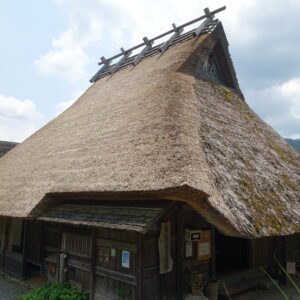

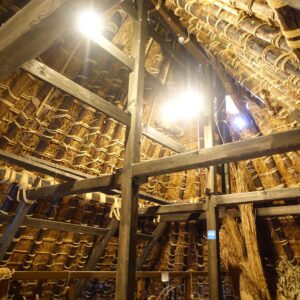
Admission: Adults Yen 300
3. Chii Hachiman Shrine
Chii Hachiman Shrine, located near “Miyama’s Thatched Village (Kayabuki-no-Sato)”, was built in 1071. The present main shrine was rebuilt in 1767. The carvings on the main shrine have earned it a reputation as a representative shrine of the Tamba region. Miyama is also located on the Saba Kaido (Wakasa Kaido) road connecting Obama in Fukui Prefecture and Kyoto. The shrine was crowded with peddlers who transported fish and other seafood. It is designated as a cultural property by Kyoto Prefecture.
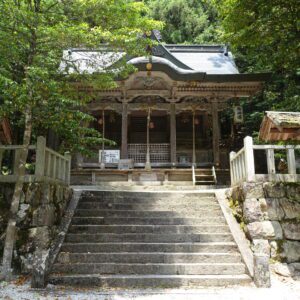
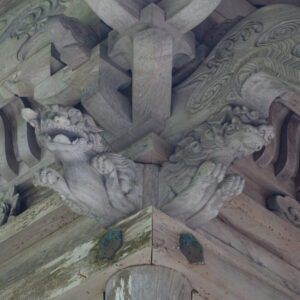
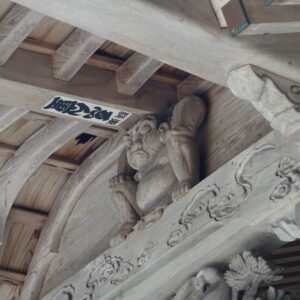
The Noh stage of Chii Hachiman Shrine is aligned between the main hall and the torii gate. Therefore, from the main hall, the mountains in front could be seen beautifully from the Noh stage, which was a wonderful view.
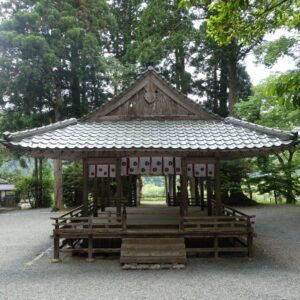
4. Kobayashi Family Residence
The Kobayashi Family Residence is a national important cultural property and was built in 1816. The Kobayashi Family was an old family that served as a deputy officer of the Sonobe Domain. It takes about 30 minutes by bicycle from “Miyama’s Thatched Village (Kayabuki-no-Sato)”. It is difficult to access on foot or by public transportation. Also, the interior of the house is not open to the public since the Kobayashi family still lives there.
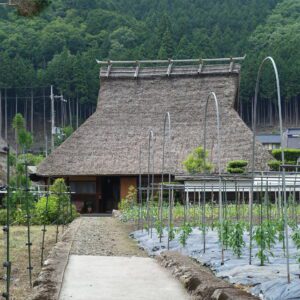
5. Nagoya City Hall / Aichi Prefectural Office
I returned the bicycle and took the bus to Hiyoshi Station. The bus I used was as follows
Depart Miyama Clinic at 14:10, Miyama Sonobe Line “bound for International University of Medical Science Hospital, arrive at Hiyoshi Station at 14:47, fare Yen 600
Nantan City buses require passengers to say where they are going before boarding. The fare is paid in advance. The boarding procedure may be difficult for foreign visitors who do not understand Japanese. Note that there is a one-day pass (Yen 1,200) that can be purchased inside the bus, which is a good deal for those who travel by public transportation without renting a bicycle.
I went from Hiyoshi station to Nagoya station via Kyoto station. The reason I went to Nagoya was to reunite with a friend from my college days after a long time. The JR train I used from Hiyoshi Station to Nagoya Station is as follows.
Depart Hiyoshi Station at 15:05, Sanin Line “bound for Sonobe, arrive at Sonobe Station at 15:14
Depart Sonobe Station at 15:17, Sanin Line “bound for Kyoto”, arrive at Kyoto Station at 15:52
Depart Kyoto Station at 16:01, Nozomi 32 “bound for Tokyo”, arrive at Nagoya Station at 16:34, total fare Yen 6,270
After arriving in Nagoya, I had some time before meeting my friend, so I toured Nagoya City Hall and other places.
The main Nagoya City Hall was completed in 1933. It is the second oldest city hall among ordinance-designated cities after Kyoto City Hall, which was completed in 1927. It is a modern building with an unusual Japanese-style tiled roof. It was designed by Kingo Hirabayashi, who also designed the Osaka Prefectural Office Building. It is designated as a national important cultural property.
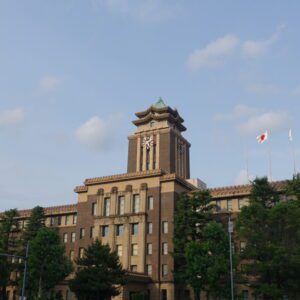
The Aichi Prefectural Government Building was completed in 1938. It is a rather unusual shaped building with a roof in the style of the great keep of Nagoya Castle. It is located next to the main Nagoya City Hall and is designated as a national important cultural property.
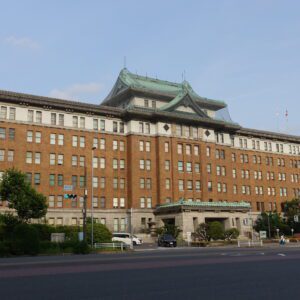
Nagoya Castle is a 5-minute walk from Nagoya City Hall and Aichi Prefectural Government Building. This time I could not see Nagoya Castle, which can be visited only until 17:00. I am posting a photo of a rainbow over Nagoya Castle that I saw during a previous visit to Nagoya, because it was so beautiful. If you compare it with the Aichi Prefectural Office Building, you will see that the roofs are almost the same color shade. Nagoya Castle’s three turrets and other structures are also designated as national important cultural property.
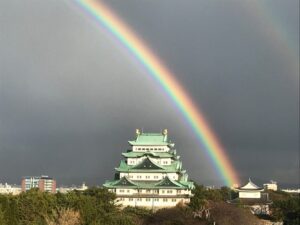
Before heading out to dinner with friends, I went to see the “Nana-chan Doll”. This giant mannequin stands 610 cm tall and weighs 600 kg in front of the Young Pavilion of the Meitetsu Department Store.
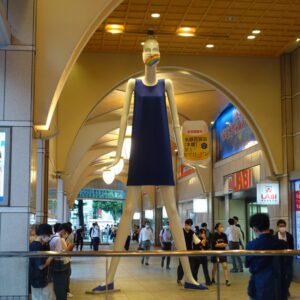
After dinner with my friend, I returned to Tokyo on the Shinkansen from Nagoya Station. The Shinkansen I used was as follows.
Depart Nagoya Station at 21:56, Nozomi 62 “bound for Tokyo”, arrive at Tokyo Station at 23:32, fare Yen 11,300
This trip to Osaka, Kyoto, and Nagoya was also very enjoyable, as I was able to eat many local dishes, seasonal seafood, and visit many sightseeing spots. Since it is difficult to travel to Kansai in July and August when it is extremely hot in the summer, a trip to Kansai in June is highly recommended.
Note: Transportation departure and arrival times, fares, entrance fees, and meal prices listed in the text are current at the time of BLOG writing. They are subject to change in the future, so please check them yourself when you travel.
